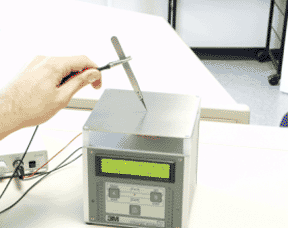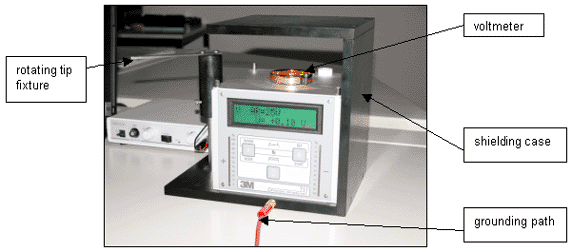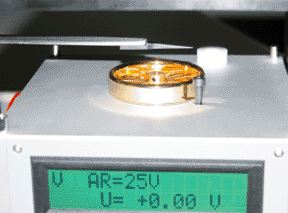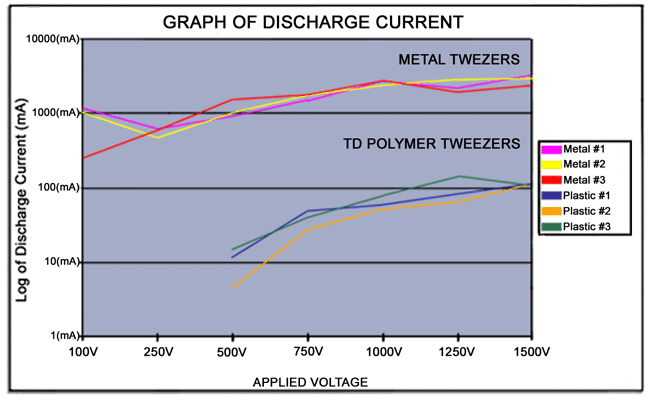“TD”® Tweezers – Quality Assurance Class 0 CDM Test Procedures
- TDI meets all of the criteria for ESD Testing, as proposed by IDEMA.
- We perform all of these “TD” Tweezers quality assurance testing procedures internally, for example the especially critical “Transient Current Discharge” testing.
POINT-TO-POINT-RESISTANCE


- Resistance Between Tip Top and Bottom (Tip Without Handle)
- Resistance Between Handle and One Tip at A Time
- Surface Resistance 100% Inspection
- Automatic PASS/FAIL Signal
The acceptance limits have been defined as follows:
- Low Resistance Limit: 1 x 106 Ohm/high resistance limit: 1 x 108 Ohm for 50 and 100V
- Low Resistance Limit: 1 x 107 Ohm/high resistance limit: 1 x 109 Ohm for 10V
STATIC DECAY ANALYSIS

The time to discharge a 20pf isolated metal plate previously charged to 1000 Volts to less than 10 Volts is measured. During the 1000 Volt discharge, sparks should not be observed. Significantly, the decay curves should have a correct exponential course.
The acceptance limits defined as follows:
- Residual Voltage < 3 Volt
- Decay Time < 500 m/second

TRIBOELECTRIC CHARGE DETERMINATION

The purpose of this discharge test is to measure any residual charges on the tweezers following normal grounding procedures as shown.
Given these points, the acceptance limits defined as follows:
- Residual Voltage < 3 Volt


- Resistance Between Tip Top and Bottom (Tip Without Handle)
- Resistance Between Handle and One Tip at A Time
- Surface Resistance 100% Inspection
- Automatic PASS/FAIL Signal
The acceptance limits have been defined as follows:
- Low Resistance Limit: 1.1006 Ohm/high resistance limit: 1.1008 Ohm for 50 and 100V
- Low Resistance Limit: 1.1007 Ohm/high resistance limit: 1.009 Ohm for 10V
STATIC DECAY ANALYSIS

The time to discharge a 20pf isolated metal plate previously charged to 1000 Volts to less than 10 Volts is measured. During the 1000 Volt discharge, sparks should not be observed. The decay curves should have a correct exponential course.
The acceptance limits defined as follows:
- Residual Voltage < 3 Volt
- Decay Time < 500 m/second

TRIBOELECTRIC CHARGE DETERMINATION

The purpose of this discharge test is to measure any residual charges on the tweezers following normal grounding procedures as shown.
The acceptance limits defined as follows:
- Residual Voltage < 3 Volt
TRANSIENT CURRENT DISCHARGE ANALYSIS

MR circuits utilized in Disk Drive Assemblies are highly static sensitive in both current and voltage ESD discharge environments.
TDI developed the “TD”® Polymer Tweezers in order to provide the lowest discharge parameters, as measured by Transient Current Discharge procedures defined by the Disk Drive Industry. TDI meets the especially critical Transient Current Discharge parameters for each Disk Drive Customer’s specifications.
The Direct Charged Device Model (DCDM) was chosen to as methodology in order to determine the transient peak current. This occurs during the discharge of a charged object through a dissipative tip tweezers.
Transient Current Determination Methodology

Test Procedure

TDI High Precision Static Dissipative “TD” ESD Safe Polymer Tip Tweezers
We pioneered the “TD”® Static Dissipative Polymer tweezers in order to meet the most critical ESD applications with excellent transient current discharge performance. < 40V ESD threshold Class 0 CDM Compliant.
Our “TD”® Static Dissipative Polymer Tweezers provide the features of a durable polymer tip material as well as self-aligning replacement tips and anti-magnetic handles. These fiber tip tweezers are perfectly balanced offering fine tip symmetry and also perfect alignment for precision handling applications.
